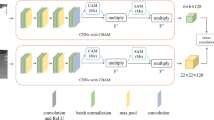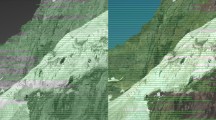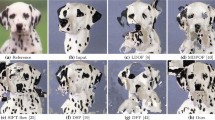Abstract
In this study, we propose a method for object matching between visible and infrared images. We consider object matching between visible and infrared images as a computational patch-matching problem, and the main solution to this problem involves calculating the similarities of the relationships between the objects in the target and search images. Therefore, in this study, we propose a Siamese neural network, which takes a pair of visible and infrared images as the input. Our proposed Siamese network comprises a convolutional neural network (CNN) to ensure the effective extraction of features from visible and infrared images. The CNN comprises convolutional and pooling layers without padding. By calculating the cross-correlation of the objects in the visible image and those in the entire infrared image, we regard the parts with the highest similarity as the matched targets. During the training process, we use focal loss to solve the problem of the imbalance between the positive and negative samples in the dataset, after which we use interpolation to determine the locations of the target patches in the infrared images. We then conduct experiments on different classes of targets, and the results demonstrate that our proposed approach achieves greater accuracy and precision than other methods.







Similar content being viewed by others
References
Lowe DG (2004) Distinctive image features from scale-invariant keypoints. International Journal Of Computer Vision 60:91–110
Dellinger F, Delon J, Gousseau Y et al (2015) SAR-SIFT: A SIFT-Like algorithm for SAR images. IEEE Trans Geosci Remote Sens 53:453–466
Ye Y, Shan J, Bruzzone L et al (2017) Robust registration of multimodal remote sensing images based on structural similarity. Ieee Transactions on Geoscience And Remote Sensing 55:2941–2958
Gao P, Zhang Q, Wang F et al (2020) Learning reinforced attentional representation for end-to-end visual tracking. Inf Sci 517:52–67
Wu Y, Jiang X, Fang Z et al (2021) Multi-modal 3D object detection by 2D-guided precision anchor proposal and multi-layer fusion. Appl Soft Comput, 108
Xu Y, Yang C, Sun B et al (2021) A novel multi-scale fusion framework for detail-preserving low-light image enhancement. Inf Sci 548:378–397
Xu Y, Sun B, Yan X et al (2020) Multi-focus image fusion using learning based matting with sum of the Gaussian-based modified Laplacian. Digital Signal Processing, p 106
Xu Y, Sun B (2020) Color-compensated multi-scale exposure fusion based on physical features. Optik, p 223
Yan X, Liu Y, Xu Y et al (2020) Multistep forecasting for diurnal wind speed based on hybrid deep learning model with improved singular spectrum decomposition. Energy Conversion And Management 225(2015):3279–3286
Hanif MS (2019) Patch match networks: Improved two-channel and Siamese networks for image patch matching. Pattern Recogn Lett 120:54–61
Liu X, Ai Y, Zhang J et al (2018) A novel affine and contrast invariant descriptor for infrared and visible image registration. Remote Sens, p 10
Dalal N, Triggs B (2005) Histograms of oriented gradients for human detection. In: Schmid C, Soatto S, Tomasi C (eds) 2005 Ieee computer society conference on computer vision and pattern recognition, vol 1, proceedings, pp 886–893
Sedaghat A, Ebadi H (2015) Remote sensing image matching based on adaptive binning SIFT descriptor. Ieee Transactions on Geoscience And Remote Sensing 53:5283–5293
Mao Y, He Z (2021) Dual-y network: infrared-visible image patches matching via semi-supervised transfer learning. Appl Intell 51:2188–2197
Zhu R, Yu D, Ji S et al (2019) Matching RGB and infrared remote sensing images with densely-connected convolutional neural networks. Remote Sens 11(23):2836
Yang Z, Dan T, Yang Y (2018) Multi-Temporal Remote sensing image registration using deep convolutional features. Ieee Access 6:38544–38555
Zhang H, Ni W, Yan W et al (2019) Registration of multimodal remote sensing image based on deep fully convolutional neural network. Ieee Journal Of Selected Topics In Applied Earth Observations And Remote Sensing 12:3028–3042
Gao P, Yuan R, Wang F et al (2020) Siamese attentional keypoint network for high performance visual tracking. Knowl-Based Syst, p 193
He H., Chen M., Chen T., Li D., Cheng P. (2019) “Learning to match multitemporal optical satellite images using multi-support-patches Siamese networks,” Remote Sensing Letters, vol 110, pp 516-525, Jun 3
Zhang Y, Po LM, Liu M et al (2020) Data-level information enhancement: Motion-patch-based Siamese Convolutional Neural Networks for human activity recognition in videos. Expert Syst Appl, p 147
Gao Y, Xiong N, Yu W, et al. (2019) Learning Identity-Aware face features across poses based on deep siamese networks. Ieee Access 105789-105799:7
Qi YK, Zhang SP, Jiang F et al (2020) Siamese local and global networks for robust face tracking. IEEE Trans. Image Process. 29:9152–9164
Krizhevsky A, Sutskever I, Hinton GE (2012) Imagenet classification with deep convolutional neural networks. In: 26Th annual conference on neural information processing systems, vol 2012, pp 1097–1105
Bertinetto L, Valmadre J, Henriques JF et al (2016) Fully-convolutional siamese networks for object tracking. In: 14Th european conference on computer vision(ECCV, vol 2016, pp 850–865
Lin T -Y, Goyal P, Girshick R et al (2020) Focal loss for dense object detection. Ieee Transactions on Pattern Analysis And Machine Intelligence 42:318–327
Kristan M, Matas J, Leonardis A et al (2019) The seventh visual object tracking VOT2019 challenge results. In: 17Th IEEE/CVF international conference on computer vision workshop(ICCVW, vol 2019, pp 2206–2241
Demsar J (2006) Statistical comparisons of classifiers over multiple data sets. Journal Of Machine Learning Research 7:1–30
Brown I, Mues C (2012) An experimental comparison of classification algorithms for imbalanced credit scoring data sets. Expert Syst Appl 39:3446–3453
Bertinetto L, Valmadre J, Golodetz S et al (2016) Staple: Complementary Learners for Real-Time Tracking. In: 2016 Ieee Conference on Computer Vision And Pattern Recognition. p 1401–1409
Galoogahi HK, Fagg A, Lucey S et al (2017) Learning Background-Aware Correlation Filters for Visual Tracking. In: 2017 Ieee International Conference on Computer Vision. p 1144–1152
Wang N, Zhou W, Tian Q et al (2018) Multi-Cue Correlation Filters for Robust Visual Tracking. In: 2018 Ieee/Cvf Conference on Computer Vision And Pattern Recognition. p 4844– 4853
Li F, Tian C, Zuo W et al (2018) Learning Spatial-Temporal Regularized Correlation Filters for Visual Tracking. In: 2018 Ieee/Cvf Conference on Computer Vision And Pattern Recognition. p 4904–4913
Li Y., Zhu J., Hoi S.C., Song W., Wang Z., Liu H. (2019) Robust estimation of similarity transformation for visual object tracking. Proceedings of the AAAI Conference on Artificial Intelligence 33(01):8666–8673
Li B, Wu W, Wang Q, et al. (2019) SIAMRPN++: Evolution Of siamese visual tracking with very deep networks. In: 32Nd IEEE/CVF conference on computer vision and pattern recognition(CVPR, vol 2019, pp 4277–4286
Lessmann S, Baesens B, Mues C et al (2008) Benchmarking classification models for software defect prediction: a proposed framework and novel findings. Ieee Transactions on Software Engineering 34:485–496
Acknowledgements
This work was supported by National Natural Science Foundation of China(Grant no.11773018, 61727802),Key Research & Development programs in Jiangsu China(Grant no. BE2018126),Fundamental Research Funds for the Central Universities(Grant no. 30919011401, 30920010001),Leading Technology of Jiangsu Basic Research Plan(BK20192003), Postgraduate Research & Practice Innovation Program of Jiangsu Province(KYCX21_0270).
Author information
Authors and Affiliations
Corresponding author
Additional information
Publisher’s note
Springer Nature remains neutral with regard to jurisdictional claims in published maps and institutional affiliations.
Rights and permissions
About this article
Cite this article
Li, W., Chen, Q., Gu, G. et al. Object matching between visible and infrared images using a Siamese network. Appl Intell 52, 7734–7746 (2022). https://doi.org/10.1007/s10489-021-02841-1
Accepted:
Published:
Issue Date:
DOI: https://doi.org/10.1007/s10489-021-02841-1




